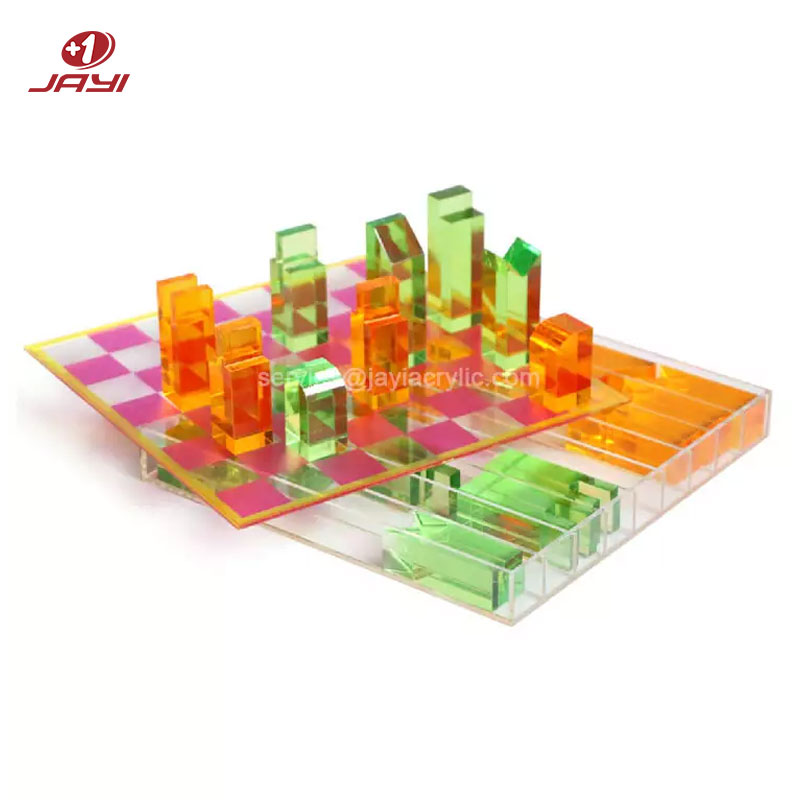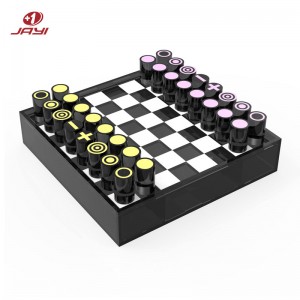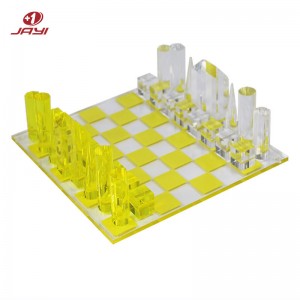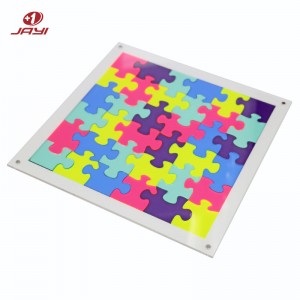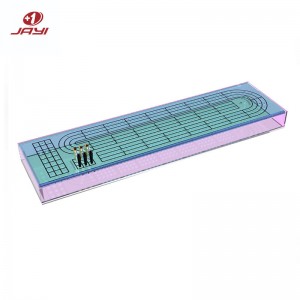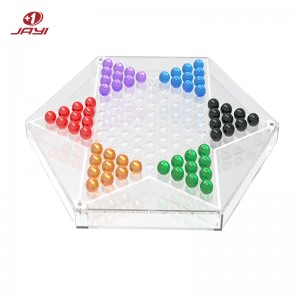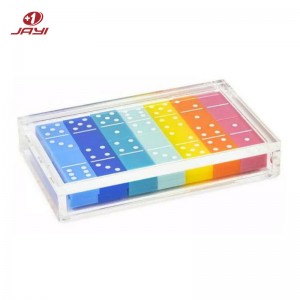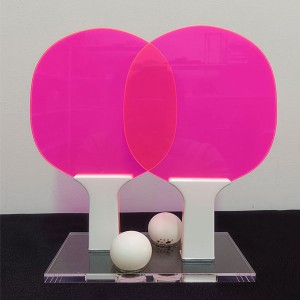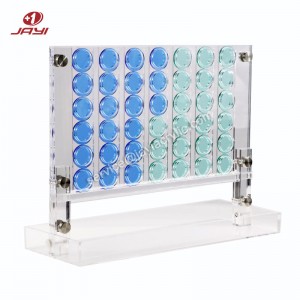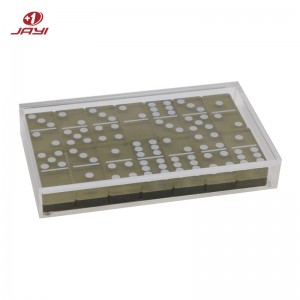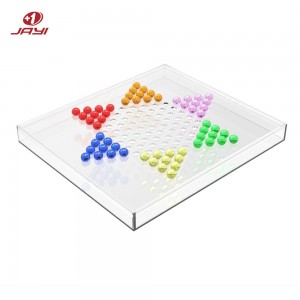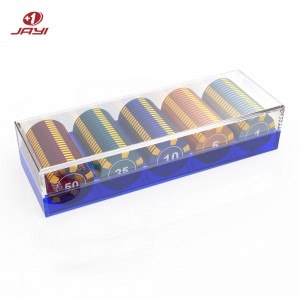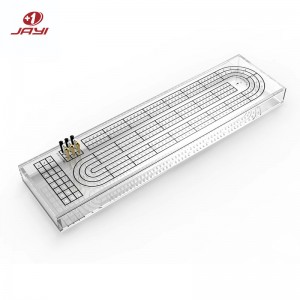Custom Acrylic Chess Game Board Set Supplier – JAYI
Get Jayi High-Quality Acrylic Chess Game Board Set To Delight Your
Customers
Jayi Acrylic has a large collection of acrylic custom chess boards in China. You can rely on our quality gaming products and reliable service. We have a strong production capacity to process your bulk orders efficiently, eliminating the hassle of multiple transactions.

Wholesale Acrylic Chess Game Set
If you are basically in need of an acrylic chess game board set and want to order in bulk, no problem! The acrylic chess game set we offer is made of 100% brand new acrylic.

Heavy Standard Acrylic Chess Set
Jayi Acrylic is not only a supplier but also the best manufacturer of the heavy standard functional acrylic chess set. It has high durability and quality, making it ideal for a variety of uses.

Personalized Acrylic Chess Game Set
Jayi Acrylic has all the collections of acrylic chess you want to order. So, you don't have to bother to go elsewhere. We can provide you with the ultimate custom solution.

Lucite Clear Acrylic Chess Game Set
Jayi Acrylic specializes in the manufacture of lucite clear acrylic chess sets that can meet your various business needs. You can save costs when you choose to buy from JAYI ACRYLIC.

Laser Cut Acrylic Chess Set
Jayi Acrylic can meet all your custom acrylic chess set needs. We always manufacture high-quality acrylic chess sets like laser-cut acrylic chess sets to suit your every preference.

China Acrylic Chess Set Manufacturer
In China, Jayi Acrylic offers modern, flexible, and stylish acrylic chess game board sets for any occasion game. Attractive custom designs are available to keep costs down.
Custom Different Types Acrylic Chess Sets and Acrylic Chess Table to Skyrocket Your Brand
Jayi's custom acrylic chess set presents an elegant and fashionable way to showcase this classic game, seamlessly blending into various environments. Our collection offers a diverse range of acrylic chess board, featuring multiple designs, colors, and finishes to suit your unique requirements.
As a specialized manufacturer of acrylic chess games, we offer wholesale and bulk sales of high-quality, modern acrylic chess sets directly from our global factories. These sets are crafted from acrylic, also widely known as Plexiglass or Perspex, which shares similarities with Lucite. This ensures durability and a sleek appearance.

Plexiglass Chess Board

Chess Board Custom

Chess Set Lucite

Lucite Chess Set

Neon Acrylic Chess Set

Chess Board Acrylic

Personalized Chess Game

Modern Acrylic Chess Set

Acrylic Chess Board

Lucite Chess Board

Luxury Acrylic Chess Set

Acrylic Chess Table
Can Not Find the Exact Acrylic Chess Set? You Need Custom It. Get to Us Now!
Please send us the drawing, and reference pictures, or share your idea as specific as possible. Advise the required quantity and lead time. Then, we will work on it.
According to your detailed requirements, Our Sales team will get back to you within 24 hours with the best-suit solution and competitive quote.
After approving the quote, we will prepare the prototyping sample for you in 3-5 days. You can confirm this by physical sample or picture & video.
Mass production will start after approving the prototype. Usually, it will take 15 to 25 working days depending on the order quantity and complexity of the project.
Best Custom Acrylic Chess Supplier and Manufacturer In China
Jayi Acrylic has been the best acrylic board games manufacturer, factory, and supplier in China since 2004. We provide integrated machining solutions including cutting, bending, CNC Machining, surface finishing, thermoforming, printing, and gluing. Meanwhile, we have experienced engineers who will design acrylic game products according to clients' requirements using CAD and Solidworks. Therefore, Jayi is one of the companies that can design and manufacture it with a cost-efficient machining solution.


Certificates From Acrylic Chess Manufacturer and Factory
The secret of our success is simple: we are a company that cares about the quality of every product, no matter how big or small. We test the quality of our products before final delivery to our customers because we know that this is the only way to ensure customer satisfaction and make us the best wholesaler in China. All our acrylic game sets products can be tested according to customer requirements (such as CA65, RoHS, ISO, SGS, ASTM, REACH, etc)
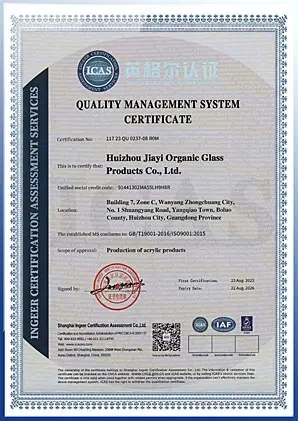

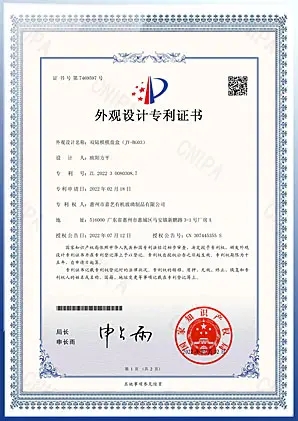
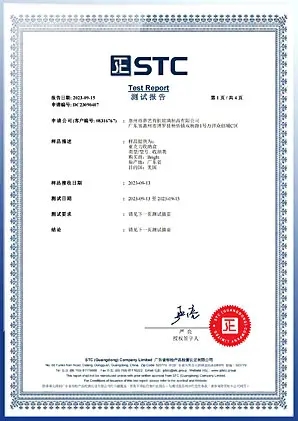
Why Choose Jayi Instead Of Others
Would You Like to View Chess Samples or Discuss Customization Options to Meet Your Specific Needs?
Please share your ideas with us; we will implement them and give you a competitive price.
Custom Acrylic Chess Sets: The Ultimate FAQ Guide
This guide discusses several aspects of an acrylic chess set, which are integral in influencing your purchase decision.
Keep reading to learn more:
Acrylic chess sets come in various types, including:
Transparent/clear sets that showcase internal designs or light-up features.
Colored acrylic sets in vibrant hues like red, blue, or green
Frosted/opaque sets for a matte aesthetic.
Some feature gradient colors, marble-like patterns, or embedded elements like metal inlays.
Foldable or magnetic acrylic boards are also popular for portability, while tournament-style sets adhere to standard piece designs.
Illuminated sets with LED bases or glow-in-the-dark acrylic are trending for decorative purposes.
Custom-engraved sets allow personalized designs or logos.

Available Types of Acrylic Chess Set
Components of Acrylic Chess Set
An acrylic chess set typically includes 32 pieces (16 for each player) mirroring traditional chess roles: 1 king, 1 queen, 2 rooks, 2 knights, 2 bishops, and 8 pawns.
The pieces are crafted from acrylic via molding or machining, often with polished surfaces for shine.
The set also comes with a chessboard, usually divided into 64 squares (32 light and 32 dark, often in contrasting acrylic colors).
Some sets include a storage box, usually acrylic or fabric-lined, to protect pieces.
Magnetic sets have embedded magnets in pieces and boards for stability, while premium sets may include a felt base on pieces to prevent scratching.
Ideal Size of Acrylic Chess Set Board
The ideal board size for an acrylic chess set depends on usage.
For casual play, a board with 2.25–2.5-inch (5.7–6.4 cm) squares is common, suitable for standard piece sizes.
Tournament regulations often recommend 2–2.25 inches per square, balancing visibility and portability.
Larger boards (3+ inches per square) are decorative or for display, while travel sets may have 1.5–1.75-inch squares.
The board’s overall dimensions typically range from 14x14 inches (35.6x35.6 cm) for smaller sets to 20x20 inches (50.8x50.8 cm) for larger ones, ensuring pieces fit comfortably without overcrowding.
Suitable Height of King in Acrylic Chess Set
The king’s height in an acrylic chess set is usually 3.5–4 inches (8.9–10.2 cm) for standard sets, matching traditional wood sets.
This height allows clear differentiation from other pieces: queens are typically 3–3.5 inches, bishops 2.5–3 inches, knights 2–2.5 inches, rooks 2–2.25 inches, and pawns 1.5–2 inches.
Tournament sets may adhere to FIDE standards (king height around 3.75 inches), while smaller travel sets might have kings as short as 2 inches.
The height should balance stability (heavier bases) with visual hierarchy on the board.
Recommended Square Size in Acrylic Chess Set Board
A recommended square size for an acrylic chess board is 2–2.5 inches (5–6.4 cm) per side.
This range ensures pieces (especially kings with 3.5–4-inch heights) have sufficient space to stand without tipping, while allowing easy movement.
For players with larger hands, 2.25–2.5 inches is more comfortable.
Smaller squares (1.5–1.75 inches) are common in travel or pocket sets, sacrificing some comfort for portability.
Decorative or outdoor sets may use 3+ inch squares for visibility, but this can make the board unwieldy.
Does Acrylic Chess Set Break Easily?
Acrylic chess sets are relatively durable but not unbreakable.
Cast acrylic is more impact-resistant than glass, but dropping heavy pieces onto the board or applying excessive force can cause chips or cracks, especially in thin sections.
High-quality acrylic with proper thickness (1/4–1/2 inch for boards) is more resilient.
Avoiding rough handling and storing pieces safely reduces breakage.
Compared to glass, acrylic is less prone to shattering, making it safer for casual use, though it’s still advisable to handle it with care.
Does Acrylic Chess Set Emit Chemical Odor?
New acrylic chess sets may have a slight chemical odor from the manufacturing process, typically from residual solvents or monomer vapors in the acrylic.
This odor is usually mild and dissipates within a few days when aired out.
High-quality sets made with virgin acrylic (not recycled) have less noticeable odors, while cheaper sets with lower-grade materials might smell stronger initially.
Baking the acrylic at low temperatures during production can reduce residual chemicals, minimizing odor.
Proper ventilation upon unpacking helps eliminate any smell quickly.
How Heavy Is Acrylic Chess Set?
The weight of an acrylic chess set varies by size and thickness.
A standard 14x14-inch board with 2.25-inch squares, 1/4-inch thick, weighs around 2–3 pounds (0.9–1.4 kg).
Pieces add to the weight: a full set of standard-sized acrylic pieces (king 3.5 inches) might weigh 1–2 pounds, making the total set 3–5 pounds.
Heavier sets with thicker boards (1/2 inch) or weighted pieces can reach 5–8 pounds.
Magnetic sets are slightly heavier due to embedded magnets, while travel sets with thinner materials may weigh under 2 pounds.
How Does Acrylic Chess Set Compare With Wood Chess Set?
Acrylic chess sets differ from wood sets in several ways.
Acrylic is more lightweight, shatter-resistant, and cheaper than premium woods like mahogany or ebony.
It offers vibrant colors and transparency, while wood has natural grain and warmth.
Acrylic sets are easier to clean (non-porous) and less prone to warping in humidity, whereas wood may require conditioning.
Wood sets often have a higher perceived value and are more durable with proper care, but acrylic is better for modern aesthetics or outdoor use.
Magnetic acrylic sets are also more portable than wood.

How Much Does Acrylic Chess Set Cost?
Acrylic chess set prices range widely based on quality, size, and features.
Budget sets start at $15–$30 for basic plastic-acrylic hybrids with small boards, suitable for beginners.
Mid-range sets ($30–$80) offer better craftsmanship, thicker boards, and weighted pieces, often with decorative elements like gradient colors.
Premium acrylic sets ($80–$200) feature hand-polished pieces, LED lighting, or custom engravings.
Tournament-standard sets cost $50–$120, while luxury illuminated or designer sets can exceed $200.
Magnetic travel sets typically cost $20–$50.
Can I Buy Pieces of Acrylic Chess Set Separately?
Yes, acrylic chess pieces can often be bought separately.
Many retailers offer replacement pieces for lost or damaged ones, with common options including kings, queens, and pawns.
Some sellers provide custom pieces to match existing sets, though color matching may vary between batches.
Specialty stores or online marketplaces (e.g., Amazon, Etsy) often list individual pieces or sets of pieces (e.g., a full set of pawns).
Ensure you know the piece dimensions (height, base diameter) to match your existing set, as sizes can vary.

How Do You Choose Most Suitable Acrylic Chess Set?
To choose the right acrylic chess set, consider purpose: travel sets need portability (foldable, magnetic), while home sets can prioritize aesthetics.
Check board size (2–2.5-inch squares for standard play) and piece height (3.5–4 inches for kings).
Weighted pieces offer better stability, and a felt base reduces noise and scratches.
Material quality matters—virgin acrylic is clearer and more durable than recycled.
For outdoor use, opt for UV-resistant acrylic to prevent yellowing.
Budget and design (transparent, colored, illuminated) also influence the choice.
Ideal Material Thickness of Acrylic Chess Board
The ideal thickness for an acrylic chess board is 1/4–1/2 inch (6–12 mm).
A 1/4-inch thickness (6 mm) is suitable for standard home or tournament sets, balancing durability and weight.
Thicker boards (3/8–1/2 inch) are more stable, less prone to warping, and better for weighted pieces, while thin boards (1/8 inch) are flimsy and reserved for novelty or travel sets.
For decorative or outdoor sets, 1/2 inch is preferable to withstand weathering or heavy use.
The thickness should match the piece weight to ensure the board doesn’t bend under pressure.
Can Acrylic Chess Set Dull With Time?
Acrylic chess sets can dull over time if not maintained properly.
Exposure to UV light, harsh chemicals, or abrasive cleaners can scratch the surface or cause it to yellow, reducing shine.
Scratches from rough handling or storage without a protective case also lead to a dull appearance.
However, regular cleaning with a soft cloth and mild soap, avoiding direct sunlight, and using a scratch-resistant coating can preserve clarity.
Dulled acrylic can sometimes be restored by polishing with a plastic polish, though deep damage may be permanent.
Can You Use Polycarbonate Chess Set Instead of Acrylic Chess Set?
Yes, polycarbonate can be used as an alternative to acrylic for chess sets, offering different advantages.
Polycarbonate is more impact-resistant than acrylic, making it ideal for outdoor use or rough handling.
It’s also lighter and less prone to yellowing from UV exposure, though it has a slightly more opaque appearance compared to acrylic’s clarity.
Polycarbonate is more flexible, which can prevent cracking but may make boards feel less rigid.
However, it’s more expensive than acrylic and harder to polish if scratched, so the choice depends on durability vs. clarity needs.
Is There Color Limitation for Acrylic Chess Set?
Acrylic chess sets have minimal color limitations due to acrylic’s versatility.
Standard colors include clear, black, white, red, blue, green, and yellow, but custom pigments allow almost any hue.
Transparent, frosted, or gradient colors are possible, as are marbled or speckled patterns.
Metallic finishes (gold, silver) or glow-in-the-dark acrylic add uniqueness.
Even neon or iridescent colors can be achieved, making acrylic ideal for vibrant, eye-catching designs.
The main constraint is the manufacturer’s color palette, but custom orders can often match specific shades.
Does Acrylic Chess Set Surface Scratch Easily?
Acrylic surfaces can scratch more easily than materials like glass or metal, especially if exposed to abrasive objects.
Keys, rough clothes, or gritty dirt can leave minor scratches on the acrylic.
However, high-quality acrylic with a protective coating is more scratch-resistant.
To minimize scratches, store pieces in a felt-lined box, clean with a soft microfiber cloth, and avoid placing the set on rough surfaces.
Light scratches can be buffed out with a plastic polish, but deep scratches may require professional restoration or replacement.
Ideal Performance Enhancement Coating for Acrylic Chess Set
A suitable performance enhancement coating for acrylic chess sets is a UV-resistant, scratch-resistant polymer coating.
This coating protects against yellowing from sunlight, reduces surface scratches, and maintains the acrylic’s clarity.
Silicone-based or polyurethane coatings are common, providing a thin, transparent layer that doesn’t affect the aesthetic.
Anti-fingerprint coatings can also be applied to minimize smudges, while anti-static coatings reduce dust attraction.
For outdoor sets, a hydrophobic coating repels water and prevents mold growth.
Why Outdoor Acrylic Chess Set Yellows in the Sun?
Outdoor acrylic chess sets turn yellow in the sun due to UV degradation.
Acrylic (PMMA) is susceptible to photochemical reactions when exposed to ultraviolet light, causing the polymer chains to break down and form yellowing compounds.
This process, called photo-oxidation, is accelerated by prolonged sunlight, heat, and humidity.
Cheaper acrylic with lower UV stabilizers yellows faster, while premium UV-resistant acrylic delays this effect.
To mitigate yellowing, use sets with added UV inhibitors or keep them covered when not in use.
How to Maintain Acrylic Chess Set?
To maintain an acrylic chess set, clean it regularly with a soft microfiber cloth and mild soap dissolved in water, avoiding abrasive cleaners.
For tough stains, use a non-abrasive plastic cleaner.
Dry the set thoroughly to prevent water spots.
Store pieces in a felt-lined box or pouch to avoid scratches, and keep the board in a protective case.
Avoid exposing the set to direct sunlight for extended periods to prevent yellowing or fading.
For minor scratches, polish with a plastic polish designed for acrylic.
Never use solvents like alcohol or acetone, as they can damage the surface.
Advantages of Acrylic Chess Set Over Other Materials
Acrylic chess sets offer several advantages: they are lightweight and shatter-resistant, ideal for travel or kids’ use.
Their transparency and vibrant colors suit modern aesthetics, while affordability makes them accessible compared to wood or metal sets.
Acrylic is non-porous, easy to clean, and resistant to moisture, preventing warping or mold.
They can incorporate features like LED lighting or magnets more easily than wood.
Outdoor sets with UV-resistant acrylic withstand weathering, and custom engraving is feasible.
Overall, acrylic balances durability, design flexibility, and cost-effectiveness.
You Might Also Like Other Custom Acrylic Board Game Products
Request An Instant Quote
We have a strong and efficient team which can offer you and instant and professional quote.
Jayiacrylic has a strong and efficient business sales team that can provide you with immediate and professional acrylic game quotes. We also have a strong design team who will quickly provide you with a portrait of your needs based on your product's design, drawings, standards, test methods, and other requirements. We can offer you one or more solutions. You can choose according to your preferences.
Acrylic Board Game Set Catalogue
Chess game board set up?
How to set up a chessboard
Orientate the board correctly. …
Set up the pawns on the board. …
Place your rooks (castles) on the board. …
Place your knights (horses) on the board. …
Place your bishops on the board. …
Place your queen on the board. …
Place your king on the board.
What is the 20 40 40 rule in chess?
Follow 20/40/40 Rule
That’s where 20/40/40 rule comes handy. For an under 2000 rated player, it makes sense to spend 20% of the time on openings, 40% on Middlegame and 40% on Endgame. Besides that, you should play practice games, solve tactics and analyze.
What are the 16 pieces in a chess set?
Each side starts with 16 pieces: eight pawns, two bishops, two knights, two rooks, one queen, and one king.
What is the 3 check rule in chess?
3-Check is a simple variant with one clear task in mind: Check the king as many times as you can! Normal rules apply, but you can also win (or lose!) a game by checking (or getting checked) 3 times in total. Games can still end in the traditional ways of checkmate, stalemate and time-out.
What is in a full chess set?
A standard chess set has 32 pieces, 16 per side. These pieces are sometimes called chessmen, but most experienced players refer to their pieces as “material.” The rules of chess govern how each piece is placed, how each piece moves across what number of squares, and whether there are any special moves permitted.

